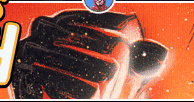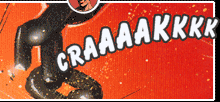   |
  |
GUARDIANS OF THE NORTH: The National Superhero in Canadian Comic-Book ArtIT'S A BIRD, IT'S A PLANE: A NEW KIND OF HERO
Humorous newspaper comic strips first emerged in North America in the 1890s. By the twenties, the "funnies" were an established popular art form in both the United States and Canada. With the advent of the Great Depression, however, comic art in North America began to change. Following the appearance in 1929 of Buck Rogers by Phil Nowlan and Dick Calkins and Tarzan by Halifax native Harold Foster, North American newspapers began to feature an increasing number of adventure strips. In a decade shaped by economic and political crises, the public's appetite for escapist adventure became insatiable. In Canada, two English-Canadian strips, Men of the Mounted and Robin Hood, both written by a Toronto Telegram journalist Ted McCall, joined already established American adventure strips of the 1930s like Dick Tracy, Brick Bradford, Flash Gordon and Prince Valiant, Harold Foster's masterpiece. In addition to this shift of content in comic strips, the 1930s witnessed the emergence of an important new form of comic art – the comic book. Starting in 1933, with the publication of Funnies on Parade, a number of publishers, including Windsor businessman Jake Geller (Comic Cuts), began to experiment with this new kind of periodical. Initially, comic books reprinted material that had originally appeared in newspaper strips. After 1935, however, when the first issue of New Fun Comics was issued, publishers began to feature original material. While these new publications were moderately successful, the release in the U.S. of one title, Action Comics (No. 1), in June 1938, resulted in the medium becoming a multi-million dollar industry, a success story which would soon inspire a similar publishing boom in Canada. This new vigour in the comic–art fields in both countries was engendered to a large degree by the appearance in Action (No. 1) of the first story about Superman, the first comic book superhero. SUPERMAN AND THE EARLY U.S. NATIONAL SUPERHEROESOriginally created in 1933 by Jerry Siegel and Toronto native Joe Shuster, two science-fiction and comic-art fans then in high school, Superman embodied not only the unbridled optimism that characterized much of the pulp science fiction of the thirties but also the romantic fantasies of adolescent boys who yearned, like Clark Kent (Superman's alter ego), to be recognized by their own Lois Lane (a journalist who was loved by Kent, but in love with Superman). Although it is obvious now that Superman and the comic book medium were made for each other, the potential of the character was not immediately recognized. In fact, until 1938 the strip was rejected by a number of publishers because it was too unrealistic, and even the eventual publisher of the character, Harry Donenfeld of National Periodical (later D.C.), is reputed to have been exceedingly nervous about the outrageous cover of Action (No. 1), which depicted Superman holding a car above his head! Donenfeld's doubts proved to be unfounded. Almost overnight, Superman struck a chord with the youthful readers of the comic books – a fact that was not lost on D.C. or its competitors. Superman was soon joined by Batman, Sub-Mariner, Captain Marvel, Plastic Man, Wonder Woman and a host of other heroes. Like Superman, most of these characters wore colourful costumes, had secret identities and possessed a variety of super-powers, which they utilized to combat evil-doers, including, not surprisingly, a growing number of super-villains. For a generation raised in the midst of the Depression, the appeal of the new genre was primal. Superheroes represented wish fulfillment of the most blatant kind. The least powerful segment of a society shaped by crushing economic and political forces eagerly embraced these dreams of power, dreams which saw seemingly average men, women and children transformed into superior beings possessing the moral authority to wield power outside the established socio-political structures. And while some critical observers of the genre might have agreed with Marshall McLuhan that "imperfect men, possessing superhuman material power, are not a reassuring prospect,"there was no doubt in the minds of young comic book fans that the heroes of Action Comics, Superman, Marvel Comics and other American titles fought for Truth, Justice and the American Way.(1) While the superhero comics were "all in color for a dime," the moral universe that they depicted was strictly black and white, and, following the outbreak of World War II in September 1939, the embodiment of evil in these comics was increasingly seen to be the aggressive Axis powers – Germany and Japan. In fact, although the United States would not enter the conflict until December 1941, the war began in U.S. comic books much earlier. Among the U.S. heroes engaged in the fight against the Nazis and the Japanese militarists was a special kind of superhero – the national superhero, a hero who symbolized the United States' pride and fighting spirit. The first of these patriotic figures (who usually wore costumes that incorporated the stars and stripes or other national iconography) was Uncle Sam, a familiar U.S. symbol borrowed from political cartooning. Uncle Sam in his somewhat unlikely incarnation as a superhero was soon followed by a far more dynamic national hero: Joe Simon and Jack Kirby's Captain America, who made his debut in Captain America Comics (No. 1). Cap (the first in a long line of comic book captains) and his sidekick, Bucky, would eventually be joined in the war effort by a number of other American national superheroes, including Minute Man, Pat Patriot, Major Victory and the Shield. Starting in 1941, however, the U.S. superheroes – national and otherwise – were not alone in fighting the Axis. North of the 49th Parallel, Canadian superheroes, including a number of national superheroes – Canada's own Guardians of the North – were entering the battle against fascism. |